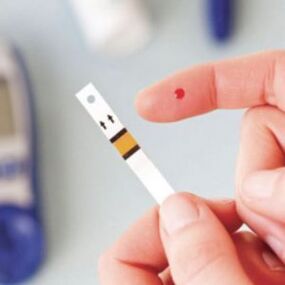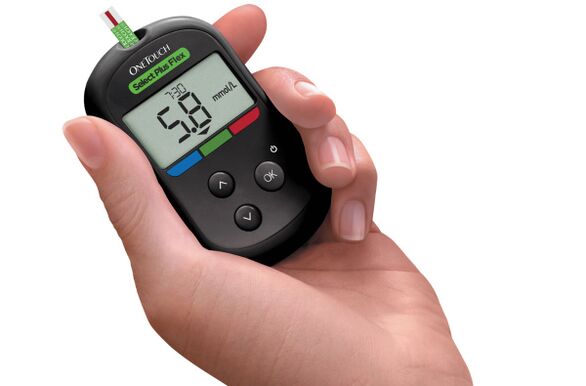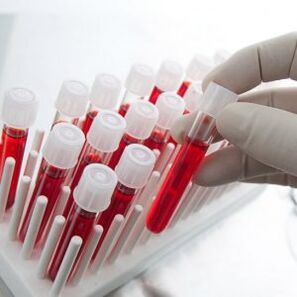
The symptoms of diabetes are a set of clinical manifestations specific to a given disease, indicating the occurrence or progression of the pathological process by doctors and patients.
Diabetes is considered one of the most common diseases in the world, and today 350 million people worldwide have suffered. According to statistics, in just two decades, the number of cases has increased by more than 10 times. About 90% of these people - the second category of diabetes.
If you determine the pathology in the initial stage, you can avoid a lot of serious complications. This is why you know what indicates the cause of the disease attack and how to check a person to control this severe endocrine pathology.
The manifestation of diabetes does not depend on its type. In this case, the body can understand when enough energy stops glucose necessary from the results of violating its metabolism, and still abundant glucose is present in the blood, causing huge irreversible damage to the system and organs. The lack of insulin lacks glucose metabolism and is therefore disturbed in the body. However, the characteristics of the pathogenesis of diabetes of the first and second types have significant differences, so it is necessary to understand their symptoms accurately.
Main symptoms
The lack of insulin or insulin-dependent cells in the blood reduces sensitivity to insulin action in the body, which leads to high glucose concentrations in the blood. In addition to being considered a symptom of major diabetes, other signs were found during the patient's medical observation. If the existence of this disease is suspected at all, it is worth seeking medical help, as early-discovered diseases are treated, and in the modern world, even school-age children begin to suffer from diabetes.
The first form of expression

As the first manifestation of diabetes, doctors call it many specific symptoms. In diabetes, patients always suffer from polyuria - rapid and abundant urination due to blood sugar and glucose levels in the urine. Glucodialysis is the cause of preventing the kidney structure from absorbing fluid. Polyuria is always accompanied by a thirst, in which one person can consume up to 10 liters of fluid per day.
Despite the consumption of so much liquid, there is still a feeling of dry mouth. If the second type of diabetes and thirst occurs, there is a persistent feeling of hunger. This is due to the fact that the pancreas produces a large amount of insulin circulates in the blood, and is not used for purposes of not using it, which gives the brain a signal about hunger.
High levels of sugar can cause serious harm to the body. Damage to nerve fibers leads to diabetic polyneuropathy. The first sign of this complication is numbness in the fingers of the feet and hands and the occurrence of severe pain in the limbs. If you start acting on glucose levels in the blood in a timely manner, the development of the process can stop, and if you don't stop at all, it will interfere with the pain syndrome and it is not that obvious. However, if you miss the beginning of pathological development, you can wait for very serious consequences - severe pain, nerves, nutritional ulcers and other things.
Diabetic vascular disease can be damaged by high blood sugar. Clinically, at first, the disease is manifested by cloud-like rod-like sensation, high concentration of glucose in the blood, then decreased vision without treatment, and even total blindness. The occurrence of any of the above symptoms, even more complex, should force the patient to check for an emergency to detect insulin deficiency.
External performance
Among the external signs, there are also some that indicate the occurrence of insulin resistance and hyperglycemia. For example, this symptom may be a sharp development of dry skin, itching and peeling. Paying attention to this skin manifestation in the context of accompanying thirst is especially important. Similarly, due to diabetes, itching often occurs on the mucus genital mucosa due to the stimulating effect of glucose in the urine. Not discharged at the same time is a unique feature of diabetes.
Similarly, weight loss is a signal of the first type of diabetes attack. In this case, it is necessary to observe some other pathological symptoms to avoid a hasty conclusion. Obesity and overweight are not symptoms of the second type of diabetes, but can be used as the cause. In any case, if a person's weight changes rapidly in any direction for no obvious reason, it is worth paying attention to this and being examined by a doctor.
Symptoms of diabetes
The first type

The first type of diabetes develops very quickly. He has his own specific form of expression to pay for.
The patient has an increase in his historical appetite, but he only loses weight, is exhausted, and suffers from lethargy. Frequent impulses do not allow them to calmly fall asleep at night, forcing them to get up a few times. With the feeling of thirst, the amount of urine in this case increases greatly.
This symptom does not attract people's attention because it suddenly occurs very much. It is accompanied by nausea, vomiting and severe irritability. It is especially important to note the ongoing impulse in the children's toilet at night if there is no previously observed.
The main problem with the first type of diabetes is that glucose levels can also increase blood and drop dramatically. Both of these states are health hazards and have their own characteristics and manifestations and must be carefully monitored.
The second type
The most common is the second type of diabetes. Its performance is very diverse, and they appear gradually, making it difficult to capture and identify them immediately. Mild symptoms usually do not lead to the fact that a person notices it at home and starts to issue an alarm immediately.
The second type of diabetes is characterized by dry mouth, thirst, rich urination, weight loss, fatigue, weakness and lethargy. One characteristic of this disease in the early stages is the presence of tingling sensation on the fingers and numbness of the limbs, hypertonic manifestations, and the occurrence of infectious processes in the urine system. Similarly, the patient's first diabetes may be disturbed by nausea and vomiting, dryness and itching, and skin infections.
It is important to remember that the gradual development of symptoms leads to the development of the disease itself. Later stage diabetes is full of high-quality comlar, lactic acidosis, ketoacidosis, and the occurrence of hypoglycemia, which can increase momentum within a few hours and may even lead to death in patients. Similarly, due to advanced diabetes, patients often experience severe vision problems, which subsequently lead to complete blindness, kidney or heart failure, pathology of the blood vessels and nervous system.
During pregnancy

Gestational sugar is rarely manifested by certain specific external signs. In most cases, its presence is through regular planned examinations to pregnant women. The main indicators are blood and urine test data.
In the presence of external signs of pregnancy type disease, they are all very similar to the symptoms of the first two types of diabetes – nausea, vomiting, weakness, craving, craving, infection in the reproductive system, are not signs of toxicity and other pathology, but in the second and third centuries surrounding the second and third representations of pregnancy, around the Gistine-style temporary monumentality.
The pathological form of pregnancy that directly threatens the life of mother and child will not bring about, but it may affect the general pregnancy process, future mother's well-being and fetus.
The high blood content in glucose can lead to the birth of a baby with a weight of more than 4 kg, which will be a prerequisite for his obesity or diabetes in any age. It can also show delays in the initial pores of newborn life, hypoglycemia, and jaundice.
Signs of complications
Diabetic feet
Diabetic foot is understood as a comprehensive anatomical and functional change in the distal part of the lower limbs of diabetic patients. This is the most powerful complication in the pathology being considered, often leading to gangrene, limb amputation and disability.

If you have a history of diabetes in a healthy leg state, you need to be monitored very carefully. There are three main forms of diabetic foot: neuropathic therapy (main nerve damage), ischemia (main lesions of blood vessels and blood flow disorders), mixed.
In the complaints of patients before diabetic feet, experts distinguished between unpleasant sensations, legs burning and sewing sensations, chicken skin ump, current discharge. If this symptom disappears while walking, it indicates the onset of development of the neurological form of the diabetic foot. It is also important to pay attention if the sensitivity disappears regularly. If you feel pain directly on foot or at night (you can only rest assured by tilting your limbs from the edge of the bed), this means the development of the ischemic form of diabetic feet is called "ischemic feet".
In signs that the development of diabetic foot begins, experts distinguish between skin on the legs or pigment spots in the area, peeling and dry skin, the occurrence of multi-mass bubbles on the skin on the skin, transparent liquid, usually cracking bones on the fingers, cracks in the cracks, cracks in the holes, cracks in the holes, cracks in the holes, cracks in the holes, cracks in the holes, cracks in the holes, deformations in the holes, deformations in the holes, deformations in the holes, holes, holes, holes, holes, holes, holes, holes, holes, holes, holes, holes, holes, holes, holes, holes, holes, holes, holes, holes, holes, holes, holes, holes, holes, holes, holes, holes, holes, holes, holes, holes, holes, holes, holes, holes, holes, holes, holes, holes, holeBones on the legs. If a person notices at least some of these signs, he should seek medical help urgently.
Signs of retinopathy
Diabetic ophthalmology is manifested by changes in blood vessels in the retina, leading to invasion of blood vessels in the microcirculation. This violation leads to diabetic retinopathy. Such complications gradually develop, even in the later stages, it is almost invisible to one person.
The main signs of diabetic retinopathy are:
- The appearance of the "flies" in front of you;
- Blurred vision;
- vision loss in later stages;
- Hemorrhage in the vitreous and retinal.
In this case, diabetic ophthalmology can manifest in two main forms - non-spheret (background) or retinal proliferative retina. Due to background retinopathy, pathological concerns are first and foremost the retinal itself. If capillary angiovascular in the retina occurs, bleeding, retinal swelling and metabolites deposition occur. Background Retinopathy is a characteristic of elderly patients with diabetes. It gradually reduces vision.
In the context, proliferative retinopathy is developing if sigal support deficiency increases. In this case, pathological formation exists in the body from the retina to the vitreous body. This process can cause bleeding in the vitreous body and keen visual progression in humans and irreversible blindness. During puberty, this transition from one form to another can occur within a few months, followed by retinal detachment and complete loss of vision.
Signs of brain disease

Diabetic encephalopathy is a complication of diabetes due to diffuse degenerative damage to the brain. The prevalence of encephalopathy depends directly on the type of diabetes and its symptoms - during the course of the disease and its severity. It is an advanced complication and manifests itself 10-15 years after the manifestation of diabetes.
The direct cause of the development of encephalopathy is the metabolic disease of diabetes, which leads to damage to brain tissue and blood vessels. The above process leads to invasion of brain activity and reduction of cognitive function. The development of encephalopathy is very slow, which makes it difficult to detect its symptoms early.
The main symptoms of diabetic encephalopathy are:
- Headache and dizziness;
- Emotional instability, high fatigue, sleep disorders and other neurological diseases;
- The human body's gait is unstable;
- Observe the forks of objects, the visual nebula, and the flickering of the "flies" in front of you;
- Mental, depression;
- Confused consciousness;
- Deterioration of psychological activities, memory, concentration ability;
- Stroke, transient ischemic attack, pathology of other cerebral circulation;
- The occurrence of epilepsy.
In the initial stage, the clinic had few complications and the symptoms began to become apparent as the encephalopathy progressed. The symptoms are the same as those of both types of diabetes.
Diabetes that often occur are atherosclerosis, arterial hypertension and obesity. In the case of atherosclerosis, associated with vascular pride, the risk of ischemic stroke and heart attack is increased. If microcirculation in renal blood vessels is violated, irreversible renal failure will occur, which will eventually lead to complete cessation of renal function. This in turn leads to the need to replace renal failure through lifelong dialysis methods.
Diabetic coma
Diabetic cats mean severely impairing the metabolic process in patients with diabetes. Coma may increase significantly, and a significant drop in human blood sugar.
This condition requires emergency medical treatment, as in the absence, there may be serious complications or even death.

Coma develops at all stages, but quickly. The first sign of confluence can be the novel state, which is blood sugar, nausea and vomiting, lethargy, daily pain, rapid growth of abdominal pain, or immediate coma. Another symptom of diabetic coma may be the irritating smell of acetone in the patient's mouth. Sensitivity can also occur in convulsions, thirst, and thirst.
Accompanied by hypoglycemia, the sugar concentration in the blood decreases sharply. This indicator can reach a mark of 2. 5 mmol per liter and below. In this obvious symptoms of coma, unreasonable anxiety, fear of the patient, feeling of weakness, cramps, decreased blood pressure and loss of consciousness stand out. The precursors for hypoglycemia coma may be:
- Generally discomfort;
- Lack of appetite;
- diarrhea or constipation;
- Dizziness, headache, tachycardia.
Lack of assistance in this state can lead to extremely serious consequences. As blood sugar-lowering coma develops rapidly, the assistance provided is urgent.
A sharp decrease in blood pressure in a patient, a weak pulse, and a softness of the eye may indicate a sharp decrease in blood pressure. Only a qualified doctor can bring his senses into his senses in this state, so the phone number of the ambulance should be followed as soon as possible.
Laboratory logo

You can reliably find out the patient's diagnosis only after all necessary laboratory tests. Any laboratory test for diabetes is designed to determine blood sugar metrics.
Sugar in the blood can be identified unexpectedly before hospitalization or before other indicators are determined urgently.
The most common blood test of sugar on an empty stomach. No consuming for 8-12 hours before delivery. Also, you cannot drink alcohol, nor smoke an hour before donating blood. Levels up to 5. 5 mmol per liter will be considered as normal indicators. If the metric equals 7 mmol per liter, the patient will be sent for additional examination. To this end, they were tested for glucose tolerance. To do this, the patient donated blood on an empty stomach, then he drank a glass of water with sugar (75 grams of adults with 200 ml of water), and then he re-examined the blood test for 2 hours.
If the body is in normal condition, the first analysis will show a maximum of 5. 5 mmol per liter and the second liter will result in 7. 8 mmol per liter. If the indicators are within this range, 5. 5-6. 7 and 7. 8-11. 1 mmol per liter, then this will tell the doctor about the patient's development of anti-antemia. Indicators that exceed these numbers indicate diabetes.
Research on glycated hemoglobin is also customary, demonstrating the average value of human glucose over the past three months. The specification is a metric below 5. 7%. If the value is between 5. 7-6. 4%, it indicates a risk of type 2 diabetes. In this case, measures should be discussed with the doctor to reduce this risk. If the level of glycated hemoglobin exceeds 6. 5%, it may be a diagnosis of diabetes, but confirmation is required. Recommended levels of glycated hemoglobin in patients with diabetes are less than 7%, and if this level is higher, it is necessary to discuss the situation with your physician. It should be kept in mind that glycated hemoglobin levels above 7% can be estimated as optimal by a physician.
Symptoms of the child
Diabetes can be manifested at any age, including early childhood. Diabetes in newborns were even discovered. This is a rare condition in the congenital nature of the disease. Most commonly, children's performance accounts for 6-12 years. During this period, children's metabolic processes proceed faster, and conditions that do not form the nervous system affect glucose levels in the blood. The younger the baby, the more complicated the diabetes.
Among the main symptoms parents need to pay attention to, doctors distinguish:
- Thirsty and dry;
- Nausea and vomiting;
- Regular urination and urine viscosity;
- Weight loss and high appetite;
- vision loss;
- High fatigue, weakness and irritability.
If the child has at least one of the above symptoms, this is the reason to look for a doctor. If several symptoms are detected at the same time, they should be done immediately.
Also in children's symptoms, typical and atypical diabetes signs may appear. Doctors attribute the typical symptoms of the child's parents often associated with age, multiple, multiple, polycrystalline, dry, dry and itchy, genitals after urination, and the amount of blood sugar 5. 5 times per liter per liter when tested for blood tests. If suspected, prompt diagnosis will help identify the disease early and initiate necessary treatments, which will not allow complications to develop.
Determine diabetes at home
The course of diabetes is absolutely asymptomatic. It can be identified randomly when visiting an optometrist or any other doctor. However, there are many signs that the existence of pathology can be independently speculated. Additionally, at home, you can determine the type of disease completely accurately.
In a healthy body, sugar levels increase after eating in the blood. After 2-3 hours thereafter, the indicator should return to its original boundary. If this does not happen, then a person will have many unnoticed symptoms. This has been considered dry mouth, thirst, very frequent and adequate urination, increased appetite, indifference, cramps, consciousness nebula. Gradually, a person begins to notice dryness in his skin that has not been shown before.
Also at home, you can suspect that all kinds of strange sensations a person has not observed before have developed diabetes. In the second type of diabetes, this is the poor healing of wounds and scratches, and the development of obesity. In the first pathology, on the contrary, a person can lose a lot of weight despite a high appetite. Similarly, for all types of diseases, itching in the skin may occur, increased hair growth on the face, formation of Xanth (small yellow growth on the skin), hair loss in the limbs, etc.
Timely identification of signs of diabetes should lead to the doctor.
Only when you start treatments for diabetes early can we hope to compensate for the disease and future normal quality of life.
























